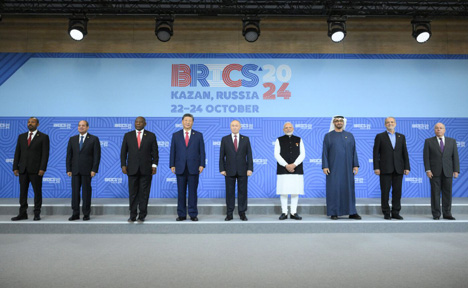
“The rancor against the BRICS group stems from Brazil’s proposal, at the last summit, to develop an alternative currency to reduce reliance on the dollar. The annoyance seems hugely out of proportion as the suggestion has little chance of becoming a reality. Wide differences in ideology and outlook among member countries militate against the formulation of such a scheme. Undoubtedly, there has been concern over the sanctions imposed on Russia after the Ukraine war kept it out of the worldwide financial settlement system known as SWIFT. This created obstacles in doing business with that country. Alternative ways are, thus, being explored to evolve a new international transaction system, but they are still at a nascent stage. As for India, it has been using a rupee payment mechanism for oil purchases from Russia, but this is merely a continuation of a longstanding arrangement harking back to the Soviet era.”

Even before being formally anointed as US President, Donald Trump‘s pronouncements are creating ripples in global economies. Recent salvos on tariffs and the dollar have sparked concerns over the prospect of trade and currency wars in the coming days. Policymakers in both developed and developing countries are voicing concerns over the impact of his new plans. While some fears are valid, given the track record in his previous tenure, others are not. Some comments are in a serious vein while others seem to be aimed merely at reasserting the primacy of the US in the world economic order.
For India, the reality is that having a stable economic relationship with the US is critical to its growth and development. This is the country’s biggest trading partner in tandem with China. But there is a significant difference between the ties with the two economic superpowers. There is a trade surplus with the former and a yawning deficit with the latter. Other disparities in the bilateral ties include the fact that investments from the US are expanding, especially as the China Plus One strategy is gaining ground. In contrast, investments from the northern neighbor have slowed down considerably recently due to strained political relations. As for the China Plus One policy, it may be one of the factors for the foreign direct investments having perked up this year. From April to September, the FDI inflows are reported to have risen by 45 per cent — from $20.5 billion to $29.79 billion.
The tariff hikes being proposed by Trump, on the other hand, could have a dampening effect on this country’s exports to its biggest market. Till recently, India had been excluded from the list of countries against which the President-elect was planning to levy higher import duties. In specific terms, so far, he has declared that a 10 per cent tariff hike would be levied on China, with an even higher 25 per cent levy on imports from the neighboring Mexico and Canada. One reason cited is the inability of these countries to curb drug smuggling into the US.
His latest acerbic comment, however, has been against the BRICS group, of which India is a founding member. Threatening to levy 100 per cent tariffs, he has taken exception to reports that an alternative currency would be floated by the group to bypass the dollar.
The rancor against the BRICS group stems from Brazil’s proposal, at the last summit, to develop an alternative currency to reduce reliance on the dollar. The annoyance seems hugely out of proportion as the suggestion has little chance of becoming a reality. Wide differences in ideology and outlook among member countries militate against the formulation of such a scheme. Undoubtedly, there has been concern over the sanctions imposed on Russia after the Ukraine war kept it out of the worldwide financial settlement system known as SWIFT. This created obstacles in doing business with that country. Alternative ways are, thus, being explored to evolve a new international transaction system, but they are still at a nascent stage. As for India, it has been using a rupee payment mechanism for oil purchases from Russia, but this is merely a continuation of a longstanding arrangement harking back to the Soviet era.
Setting this issue aside, therefore, one must examine the real problems on the tariff front. On the negative side, the prospect of a global trade war could lead to recessionary conditions in some of India’s key markets. To that extent, this could affect exports, especially to Europe and the Americas. There is also a possibility that tariffs could be raised on exports to the lucrative US market in retaliation for the relatively higher duties imposed on imports here. Trump has repeatedly cited the instance of Harley Davidson, which was unable to enter the Indian market due to high tariffs. It is inevitable that easier access to the sizable domestic market would be sought by the new US administration, as has been done in the past. The difference now is that there is a real likelihood of retaliatory tariffs.
On the positive side, this could be just the push needed for this government to shift from its recent policies of hiking import tariffs. The process has been continuing gradually for the past few years in the guise of launching the “Make in India” programme. This has raised the real danger of protectionism in the form of tariff walls to insulate the domestic industry, as was done in the License raj era. While some sectors may genuinely need protection, by and large, the Indian industry is at a more resilient stage than ever in the past. Besides, if this country is to plug into the global supply chains, it must rethink the entire strategy on import levies. Raising revenues should not be the rationale for putting a high tariff regime in place.
The other advantage that could arise from Trump’s plans to hike tariffs on goods from China is that Indian exporters could gain a competitive edge. Several studies have emerged highlighting the potential for growth in sectors like textiles, information technology and pharmaceuticals. Apart from these gains, it is possible that investors will shift out of China to avoid the punitive tariffs imposed on imports from there. Though some of this movement may benefit smaller economies like Vietnam and Indonesia, larger ventures would prefer India for relocation. It has the benefits of low-cost labor and availability of skilled manpower, especially in high-tech areas.
India, thus, needs to review its own inward-looking policies while considering the way forward in dealing with the tectonic shift in tariffs envisaged by the incoming administration. It may not be easy going as Trump has already pronounced this country to be an abuser of tariffs. There are bound to be tough negotiations as the US seeks greater access to the temptingly large Indian market. Dealing with more aggressive trade diplomacy will mean adopting a more flexible approach, especially as this country cannot afford to continue raising protectionist walls in a globalized world. This may be a radical change from the past, but it could ultimately benefit trade and industry in the long run.
(The author is a journalist and writes on economy)




Be the first to comment